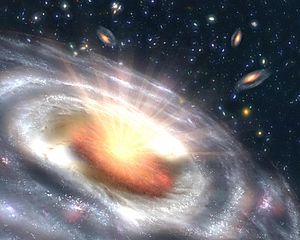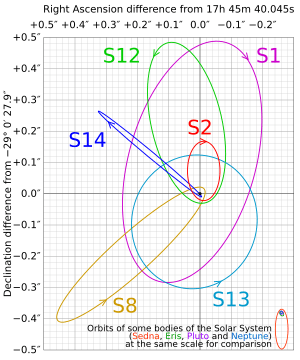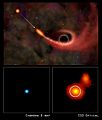Supermassive black hole facts for kids
A supermassive black hole (often called SMBH) is a type of black hole that is incredibly huge. It can be between 100,000 and 10 billion times heavier than our Sun. Scientists are pretty sure that almost every galaxy, including our own Milky Way galaxy, has one of these giant black holes right at its center.
Contents
How Do Supermassive Black Holes Form?
Scientists are still trying to figure out exactly how supermassive black holes first started. They do know that once a black hole is in the middle of a galaxy, it can get bigger. It grows by pulling in gas, dust, and stars around it. It can also grow by crashing into and joining with other black holes.
We know how regular, smaller black holes form. These are made when very big stars die and collapse. But there's a big difference in size between these "star-sized" black holes and the supermassive ones.
Star-sized black holes are usually up to about 33 times the mass of the Sun. But the smallest supermassive black holes are at least 100,000 times the Sun's mass. This huge gap suggests that they might form in different ways.
Observations show that objects called quasars were much more common when the Universe was young. Quasars are very bright centers of galaxies, powered by growing supermassive black holes. Some supermassive black holes, billions of times heavier than the Sun, had already formed when the Universe was less than one billion years old. This means these giant black holes appeared very early in the Universe, inside the first huge galaxies.
Our Milky Way's Supermassive Black Hole
Astronomers are very confident that our own Milky Way galaxy has a supermassive black hole at its center. It's about 26,000 light-years away from our Solar System. You can find it in the direction of the constellation Sagittarius. This area is called Sagittarius A* (pronounced "Sagittarius A-star").
Here's why scientists believe it's a black hole:
- One star, named S2, moves in an oval-shaped path around this central object. It takes 15.2 years to complete one orbit. At its closest point, it comes within 17 light hours of the center. That's about 120 times the distance from the Earth to the Sun!
- By watching how star S2 moves, scientists can figure out the mass of the object it's orbiting. They estimate it's about 4.1 million times the mass of our Sun.
- The central object must be much smaller than 17 light hours across. If it were bigger, star S2 would either crash into it or be torn apart by its strong gravity. Recent observations show its size is no more than 6.25 light hours, which is roughly the size of Uranus's orbit.
- Only a black hole is dense enough to pack 4.1 million times the Sun's mass into such a small space.
Scientists from the Max Planck Institute for Extraterrestrial Physics and the UCLA have gathered strong evidence that Sagittarius A* is indeed a supermassive black hole. They used data from powerful telescopes like the ESO and the Keck telescope. Our galaxy's central black hole is thought to be about 4.1 million times the mass of the Sun.
Images for kids
-
An artist's drawing of a supermassive black hole surrounded by a spinning disk of gas and dust called an accretion disk. It is also shooting out powerful jets.
See also
 In Spanish: Agujero negro supermasivo para niños
In Spanish: Agujero negro supermasivo para niños









